Archway Road Huyton Liverpool Merseyside L36 9UJ
The pub was built on the site of Barker’s Brewery, run by the brothers Richard and William Barker and was founded on this site in 1825. The brewery site extended forward onto what is now the dual carriageway. In front of Barker’s Brewery was the original Rose & Crown, once a coaching inn which stopped trading as a public house in 1938 and was demolished for road widening in 1967.
A plaque documenting the history of The Barker’s Brewery.
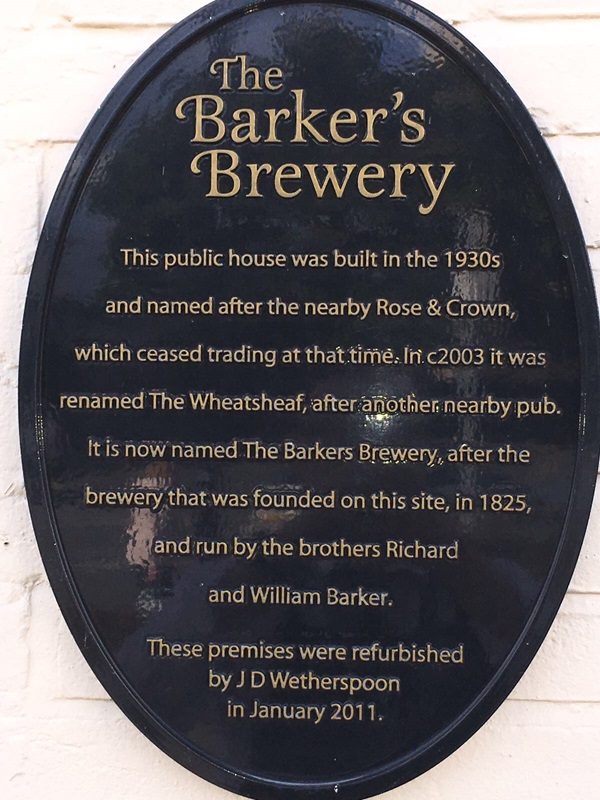
The text reads: The public house was built in the 1930s and named after the nearby Rose & Crown, which ceased trading at that time. In c2003 it was renamed The Wheatsheaf, after another nearby pub. It is now named The Barker’s Brewery, after the brewery that was founded on this site, in 1825, and run by the brothers Richard and William Barker.
These premises were refurbished by J D Wetherspoon in January 2011.
A photograph and text about the history of brewing beer.
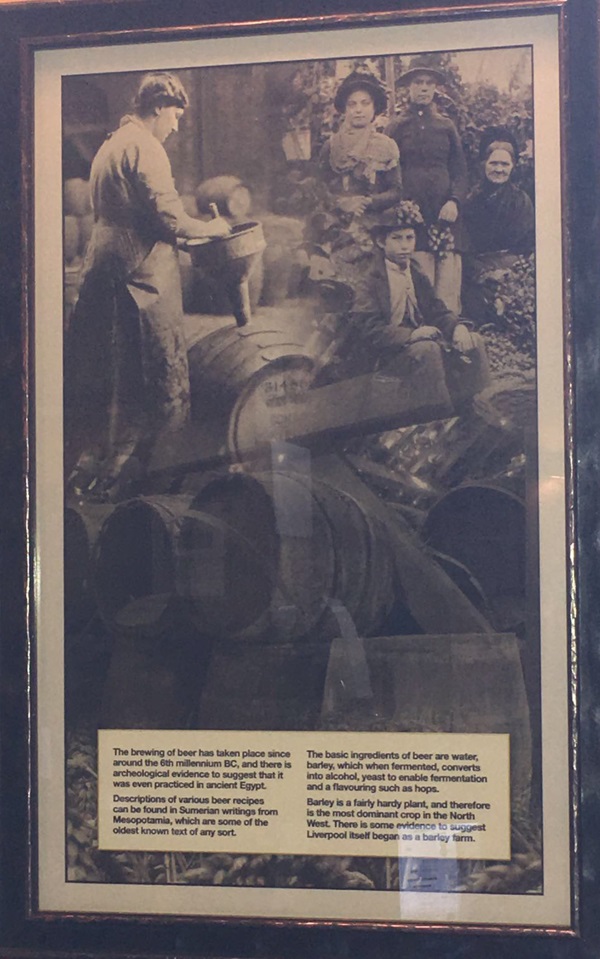
The text reads: The brewing of beer has taken place since around the 6th millennium BC, and there is archaeological evidence to suggest that it was even practiced in ancient Egypt. Descriptions of various beer recipes can be found in Sumerian writings from Mesopotamia, which are some of the oldest known text of any sort. The basic ingredients of beer are water, barley which is fermented, converts into alcohol, yeast to enable fermentation and a flavouring such as hops. Barley is a fairly hardy plant, and therefore is the most dominant crop in the north west. There is some evidence to suggest Liverpool itself began as a barley farm.
A photograph and text about Barker’s Brewery.
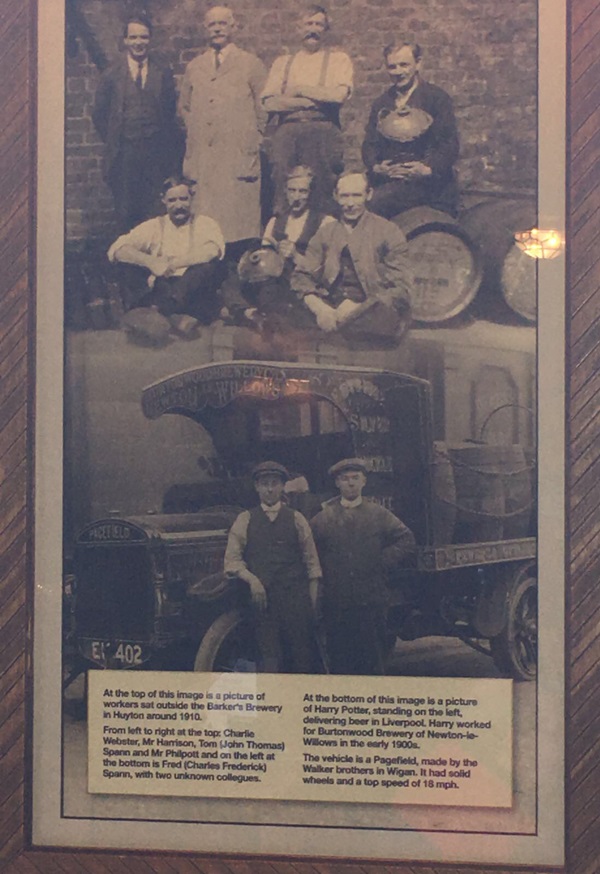
The text reads: At the top of this image is a picture of workers sat outside the Barker’s Brewery in Huyton around 1910.
From left to right at the top: Charlie Webster, Mr Harrison, Tom (John Thomas) Spann and Mr Philpott and on the left at the bottom is Fred (Charles Frederick) Spann, with two unknown colleagues.
At the bottom of this image is a picture of Harry Potter, standing on the left, delivering beer in Liverpool. Harry worked for Burtonwood Brewery of Newton-le-Willows in the early 1900s.
The vehicle is a Pagefield, made by the Walker brothers in Wigan. It had solid wheels and a top speed of 18 mph.
An illustration and text about John Kemble.
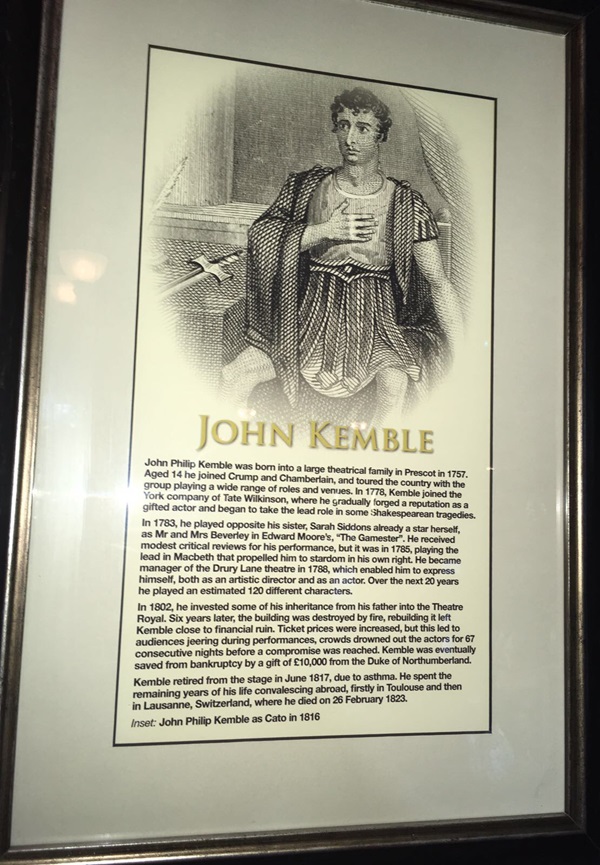
The text reads: John Philip Kemble was born into a large theatrical family in Prescot in 1757. Aged 14 he joined Crump and Chamberlain, and toured the country with the group playing a wide range of roles and venues. In 1778, Kemble joined the York company of Tate Wilkinson, where he gradually forged a reputation as a gifted actor and began to take the lead role in some Shakespearean tragedies.
In 1783, he played opposite his sister, Sarah Siddons already a star herself, as Mr and Mrs Beverley in Edward Moore’s, The Gamester. He received modest critical reviews for his performance, but it was in 1785, playing the lead in Macbeth that propelled him to stardom in his own right. He became manager of the Drury Lane theatre in 1788, which enabled him to express himself, both as an artistic director and as an actor. Over the next 20 years he played an estimated 120 different characters.
In 1802, he invested some of his inheritance from his father into the Theatre Royal. Six years later, the building was destroyed by fire, rebuilding it left Kemble close to financial ruin. Ticket prices were increased, but this led to audiences jeering during performances, crowds drowned out the actors for 67 consecutive nights before a compromise was reached. Kemble was eventually saved from bankruptcy by a gift of £10,000 from the Duke of Northumberland.
Kemble retired from the stage in June 1817, due to asthma. He spent the remaining years of his life convalescing abroad, firstly in Toulouse and then in Lausanne, Switzerland, where he died on 26 February 1823.
Inset: John Phillip Kemble as Cato in 1816.
Photographs and text about Sir Rex Harrison.
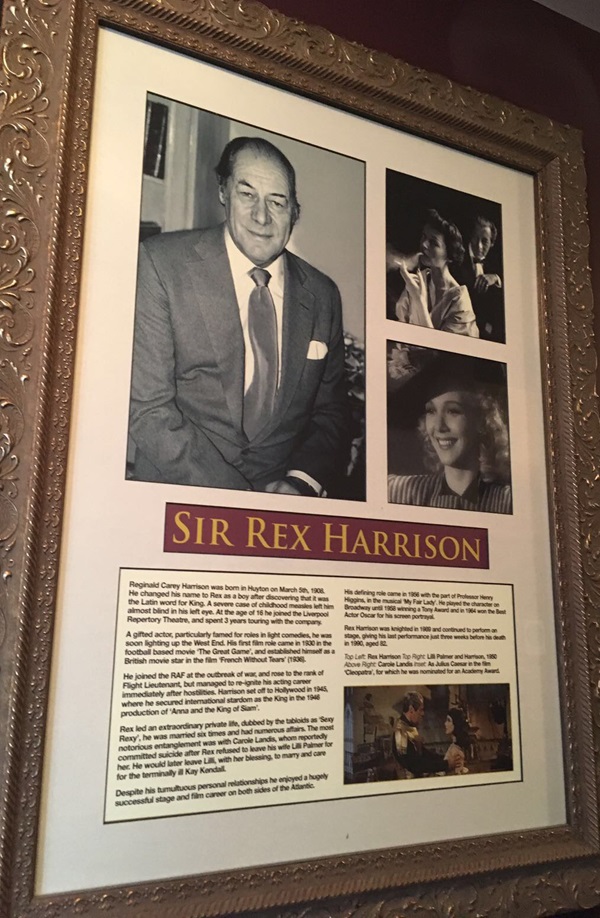
The text reads: Reginald Carey Harrison was born in Huyton on March 5 1908. He changed his name to Rex as a boy after discovering that it was the Latin word for King. A severe case of childhood measles left him almost blind in his left eye. At the age of 16 he joined the Liverpool Repertory Theatre, and spent 3 years touring with the company.
A gifted actor, particularly famed for roles in light comedies, he was soon lighting up the West End. His first film role came in 1930 in the football based movie The Great Game, and established himself as a British movie star in the film French Without Tears (1936).
He joined the RAF at the outbreak of war and rose to the rank of Flight Lieutenant, but managed to re-ignite his acting career immediately after hostilities. Harrison set off to Hollywood in 1945, where he secured international stardom as the King in the 1946 production of Anna and the King of Siam.
Rex led an extraordinary private life, dubbed by the tabloids as Sexy Rexy, he was married six times and had numerous affairs. The most notorious entanglement was with Carole Landis, whom reportedly committed suicide after Rex refused to leave his wife Lilli Palmer for her. He would later leave Lilli, with her blessing, to marry and care for the terminally ill Kay Kendall.
Despite his tumultuous personal relationships he enjoyed a hugely successful stage and film career on both sides of the Atlantic.
His delivering role came in 1966 with the part of Professor Henry Higgins, in the musical My Fair Lady. He played the character on Broadway until 1968 winning a Tony Award and in 1964 won the Best Actor Oscar for his screen portrayal.
Rex Harrison was knighted in 1969 and continued to perform on stage, giving his last performance just three weeks before his death in 1990, aged 82.
Top left: Rex Harrison
Top Right: Lilli Palmer and Harrison, 1950
Above right: Carole Landis
Inset: As Julius Caesar in the film Cleopatra, for which he was nominated for an Academy Award.
Illustrations, a photograph and text about Knowsley Hall.
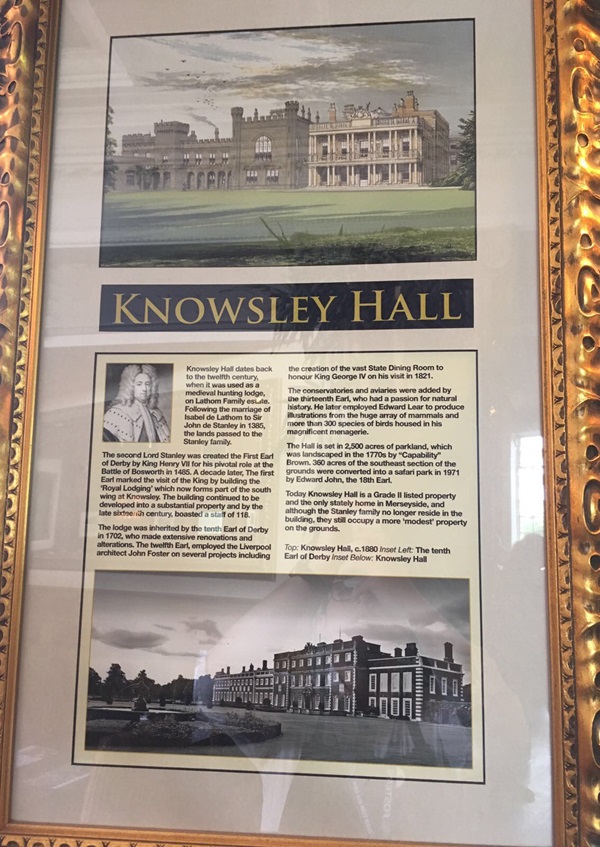
The text reads: Knowsley Hall dates back to the twelfth century, when it was used as a medieval hunting lodge, on Lathom Family estate. Following the marriage of Isabel de Lathom to Sir John de Stanley in 1385, the lands passed to the Stanley family.
The second Lord Stanley was created the First Earl of Derby by King Henry VII for his pivotal role at the Battle of Bosworth in 1485. A decade later, the First Earl marked the visit of the King by building the Royal Lodging which now forms part of the south wing at Knowsley. The building continued to be developed into a substantial property and by the late sixteenth century, boasted a staff of 118.
The lodge was inherited by the tenth Earl of Derby in 1702, who made extensive renovations and alterations. The twelfth Earl, employed the Liverpool architect John Foster on several projects including the creation of the vast State Dining Room to honour King George IV on his visit in 1821.
The conservatories and aviaries were added by the thirteenth Earl, who had a passion for natural history. He later employed Edward Lear to produce illustrations from the huge array of mammals and more than 300 species of birds housed in his magnificent menagerie.
The Hall is set in 2,500 acres of parkland, which was landscaped in the 1770s by Capability Brown. 360 acres of the southeast section of the grounds were converted into a safari park in 1971 by Edward John, the 18th Earl.
Today Knowsley Hall is a Grade II listed property and the only Stanley home in Merseyside, and although the Stanley family no longer reside in the building, they still occupy a more modest property on the grounds.
Top: Knowsley Hall, c1880
Inset left: The tenth Earl of Derby
Inset Below: Knowsley Hall
An oil painting entitled The Wheatsheaf, Huyton, by Will Simmons.
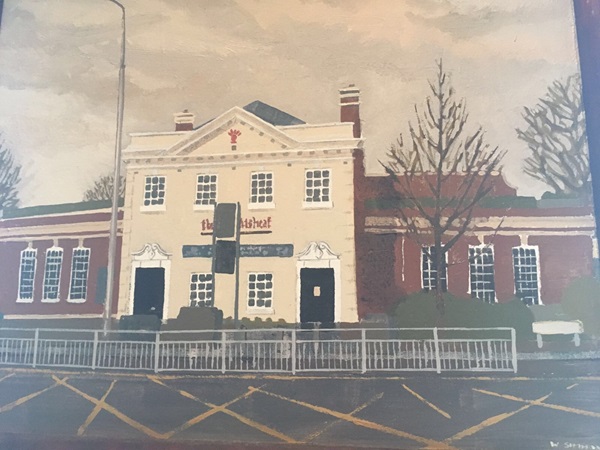
I was delighted to be commissioned by J D Wetherspoon to produce this painting. Before it was renamed the Wheatsheaf in 2003, this large public house was The Rose and Crown. Built in the 1930s, the pub stands on the site of the former Barker’s Brewery which was founded in 1825 by Richard Barker.
An original sculpture of Richard Barker, by David Webster.
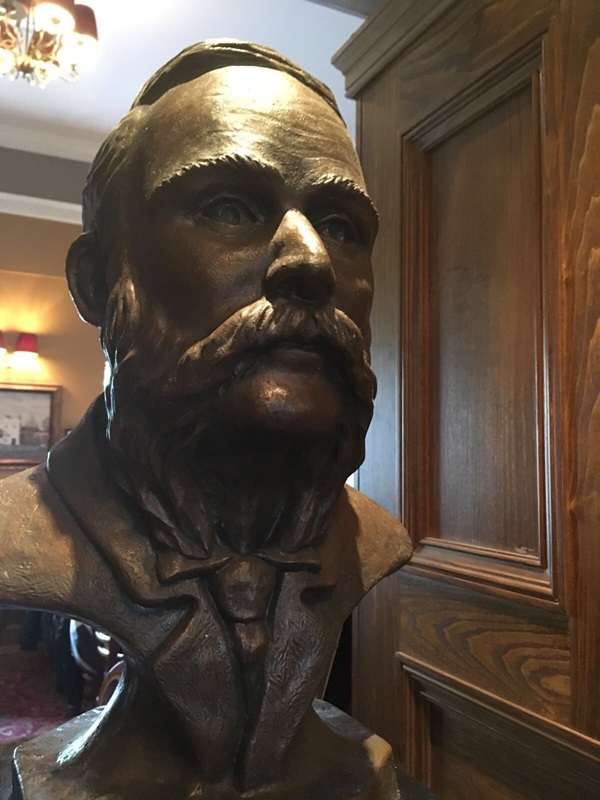
This bust is of Richard Barker who was the third of four generations of Barker’s that managed the brewery that used to sit on the site of this pub.
Huyton Brewery known locally as Barker’s Brewery, passed to a fourth generation when George Guyse Barker (born 1860) and his brother Cecil Charlwood Barker (Born 1862) became directors. Their leadership continued until George G. Barker’s death in 1925. This marked the end of the Barker family’s involvement in the brewery business.

If you have information on the history of this pub, then we’d like you to share it with us. Please e-mail all information to: pubhistories@jdwetherspoon.co.uk